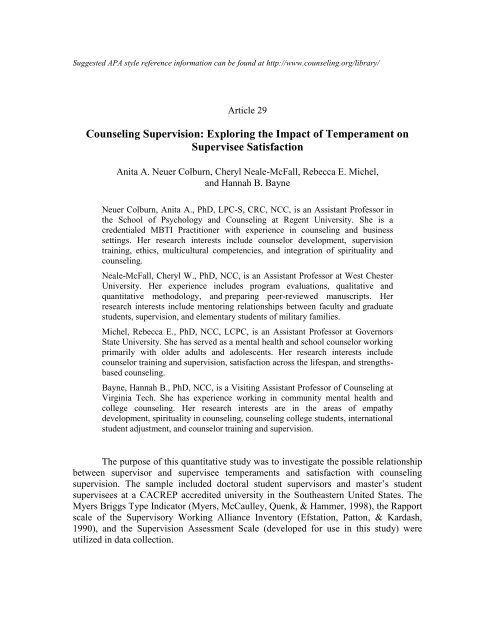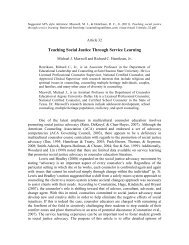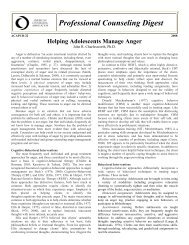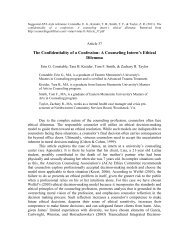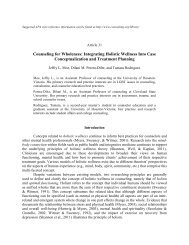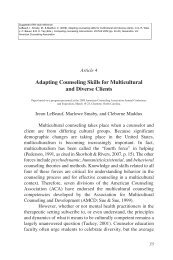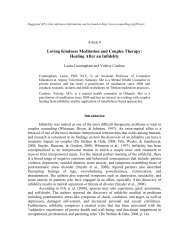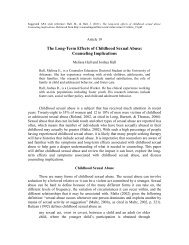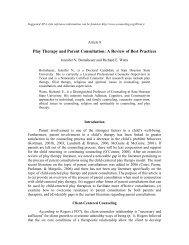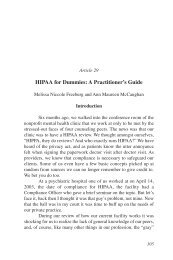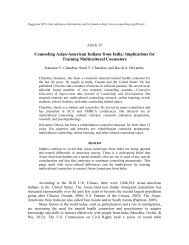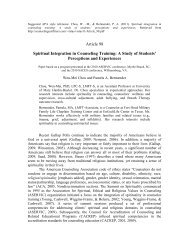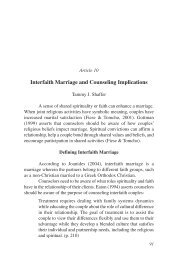Counseling Supervision: Exploring the Impact of Temperament on ...
Counseling Supervision: Exploring the Impact of Temperament on ...
Counseling Supervision: Exploring the Impact of Temperament on ...
Create successful ePaper yourself
Turn your PDF publications into a flip-book with our unique Google optimized e-Paper software.
Suggested APA style reference informati<strong>on</strong> can be found at http://www.counseling.org/library/<br />
Article 29<br />
<str<strong>on</strong>g>Counseling</str<strong>on</strong>g> <str<strong>on</strong>g>Supervisi<strong>on</strong></str<strong>on</strong>g>: <str<strong>on</strong>g>Exploring</str<strong>on</strong>g> <str<strong>on</strong>g>the</str<strong>on</strong>g> <str<strong>on</strong>g>Impact</str<strong>on</strong>g> <str<strong>on</strong>g>of</str<strong>on</strong>g> <str<strong>on</strong>g>Temperament</str<strong>on</strong>g> <strong>on</strong><br />
Supervisee Satisfacti<strong>on</strong><br />
Anita A. Neuer Colburn, Cheryl Neale-McFall, Rebecca E. Michel,<br />
and Hannah B. Bayne<br />
Neuer Colburn, Anita A., PhD, LPC-S, CRC, NCC, is an Assistant Pr<str<strong>on</strong>g>of</str<strong>on</strong>g>essor in<br />
<str<strong>on</strong>g>the</str<strong>on</strong>g> School <str<strong>on</strong>g>of</str<strong>on</strong>g> Psychology and <str<strong>on</strong>g>Counseling</str<strong>on</strong>g> at Regent University. She is a<br />
credentialed MBTI Practiti<strong>on</strong>er with experience in counseling and business<br />
settings. Her research interests include counselor development, supervisi<strong>on</strong><br />
training, ethics, multicultural competencies, and integrati<strong>on</strong> <str<strong>on</strong>g>of</str<strong>on</strong>g> spirituality and<br />
counseling.<br />
Neale-McFall, Cheryl W., PhD, NCC, is an Assistant Pr<str<strong>on</strong>g>of</str<strong>on</strong>g>essor at West Chester<br />
University. Her experience includes program evaluati<strong>on</strong>s, qualitative and<br />
quantitative methodology, and preparing peer-reviewed manuscripts. Her<br />
research interests include mentoring relati<strong>on</strong>ships between faculty and graduate<br />
students, supervisi<strong>on</strong>, and elementary students <str<strong>on</strong>g>of</str<strong>on</strong>g> military families.<br />
Michel, Rebecca E., PhD, NCC, LCPC, is an Assistant Pr<str<strong>on</strong>g>of</str<strong>on</strong>g>essor at Governors<br />
State University. She has served as a mental health and school counselor working<br />
primarily with older adults and adolescents. Her research interests include<br />
counselor training and supervisi<strong>on</strong>, satisfacti<strong>on</strong> across <str<strong>on</strong>g>the</str<strong>on</strong>g> lifespan, and strengthsbased<br />
counseling.<br />
Bayne, Hannah B., PhD, NCC, is a Visiting Assistant Pr<str<strong>on</strong>g>of</str<strong>on</strong>g>essor <str<strong>on</strong>g>of</str<strong>on</strong>g> <str<strong>on</strong>g>Counseling</str<strong>on</strong>g> at<br />
Virginia Tech. She has experience working in community mental health and<br />
college counseling. Her research interests are in <str<strong>on</strong>g>the</str<strong>on</strong>g> areas <str<strong>on</strong>g>of</str<strong>on</strong>g> empathy<br />
development, spirituality in counseling, counseling college students, internati<strong>on</strong>al<br />
student adjustment, and counselor training and supervisi<strong>on</strong>.<br />
The purpose <str<strong>on</strong>g>of</str<strong>on</strong>g> this quantitative study was to investigate <str<strong>on</strong>g>the</str<strong>on</strong>g> possible relati<strong>on</strong>ship<br />
between supervisor and supervisee temperaments and satisfacti<strong>on</strong> with counseling<br />
supervisi<strong>on</strong>. The sample included doctoral student supervisors and master’s student<br />
supervisees at a CACREP accredited university in <str<strong>on</strong>g>the</str<strong>on</strong>g> Sou<str<strong>on</strong>g>the</str<strong>on</strong>g>astern United States. The<br />
Myers Briggs Type Indicator (Myers, McCaulley, Quenk, & Hammer, 1998), <str<strong>on</strong>g>the</str<strong>on</strong>g> Rapport<br />
scale <str<strong>on</strong>g>of</str<strong>on</strong>g> <str<strong>on</strong>g>the</str<strong>on</strong>g> Supervisory Working Alliance Inventory (Efstati<strong>on</strong>, Patt<strong>on</strong>, & Kardash,<br />
1990), and <str<strong>on</strong>g>the</str<strong>on</strong>g> <str<strong>on</strong>g>Supervisi<strong>on</strong></str<strong>on</strong>g> Assessment Scale (developed for use in this study) were<br />
utilized in data collecti<strong>on</strong>.
Ideas and Research You Can Use: VISTAS 2012, Volume 1<br />
Counselor supervisi<strong>on</strong> has received much attenti<strong>on</strong> in recent years, with various<br />
models informing its practice. One recent trend has been <str<strong>on</strong>g>the</str<strong>on</strong>g> acknowledgement <str<strong>on</strong>g>of</str<strong>on</strong>g> <str<strong>on</strong>g>the</str<strong>on</strong>g><br />
importance <str<strong>on</strong>g>of</str<strong>on</strong>g> a str<strong>on</strong>g, collaborative relati<strong>on</strong>ship in generating positive supervisi<strong>on</strong><br />
outcomes (Ellis, 2001; Falender, 2010; Lizzio, Wils<strong>on</strong>, & Que, 2009; Pears<strong>on</strong>, 2000;<br />
Trepal, Bailie, & Leeth, 2010). Despite this trend, <str<strong>on</strong>g>the</str<strong>on</strong>g>re is scant literature examining<br />
specific relati<strong>on</strong>al processes and <str<strong>on</strong>g>the</str<strong>on</strong>g> influence <str<strong>on</strong>g>of</str<strong>on</strong>g> pers<strong>on</strong>ality differences <strong>on</strong> <str<strong>on</strong>g>the</str<strong>on</strong>g> quality <str<strong>on</strong>g>of</str<strong>on</strong>g><br />
supervisi<strong>on</strong> relati<strong>on</strong>ships (Lochner & Melchert, 1997; Swans<strong>on</strong> & O’Saben, 1993). This<br />
gap suggests an important area for development in supervisi<strong>on</strong> research and practice. As<br />
pers<strong>on</strong>ality variables are pivotal to successful <str<strong>on</strong>g>the</str<strong>on</strong>g>rapeutic relati<strong>on</strong>ships and outcomes, so<br />
too could percepti<strong>on</strong>s <str<strong>on</strong>g>of</str<strong>on</strong>g> <str<strong>on</strong>g>the</str<strong>on</strong>g> quality <str<strong>on</strong>g>of</str<strong>on</strong>g> <str<strong>on</strong>g>the</str<strong>on</strong>g> supervisory relati<strong>on</strong>ship be influenced by<br />
supervisor and supervisee pers<strong>on</strong>ality preferences (Lochner & Melchert, 1997; Schacht,<br />
Howe, & Berman, 1989).<br />
Literature Review<br />
<str<strong>on</strong>g>Supervisi<strong>on</strong></str<strong>on</strong>g> Relati<strong>on</strong>ships<br />
Research in <str<strong>on</strong>g>the</str<strong>on</strong>g> field <str<strong>on</strong>g>of</str<strong>on</strong>g> clinical supervisi<strong>on</strong> has <str<strong>on</strong>g>of</str<strong>on</strong>g>ten focused <strong>on</strong> <str<strong>on</strong>g>the</str<strong>on</strong>g> importance<br />
<str<strong>on</strong>g>of</str<strong>on</strong>g> <str<strong>on</strong>g>the</str<strong>on</strong>g> relati<strong>on</strong>ship between supervisor and supervisee (Bernard & Goodyear, 2009; Ellis,<br />
2001; Falender, 2010; Gray, Ladany, Walker, & Ancis, 2001; Hart & Nance, 2003;<br />
Nels<strong>on</strong> & Friedlander, 2001; Pears<strong>on</strong>, 2000). Specifically, <str<strong>on</strong>g>the</str<strong>on</strong>g> perceived quality <str<strong>on</strong>g>of</str<strong>on</strong>g> <str<strong>on</strong>g>the</str<strong>on</strong>g><br />
relati<strong>on</strong>ship has been linked with improved supervisi<strong>on</strong> outcomes, higher satisfacti<strong>on</strong><br />
with supervisi<strong>on</strong>, increased self-disclosure in supervisi<strong>on</strong>, and increased use <str<strong>on</strong>g>of</str<strong>on</strong>g> clinically<br />
appropriate counseling behaviors (Ellis, 2001; Falender, 2010; Mehr, Ladany, & Caskie,<br />
2010; Nels<strong>on</strong> & Friedlander, 2001; Protivnak & Davis, 2008). Additi<strong>on</strong>ally, recent<br />
studies have suggested that regardless <str<strong>on</strong>g>of</str<strong>on</strong>g> <str<strong>on</strong>g>the</str<strong>on</strong>g> model or <str<strong>on</strong>g>the</str<strong>on</strong>g>oretical approach used in<br />
supervisi<strong>on</strong>, <str<strong>on</strong>g>the</str<strong>on</strong>g> quality <str<strong>on</strong>g>of</str<strong>on</strong>g> <str<strong>on</strong>g>the</str<strong>on</strong>g> relati<strong>on</strong>ship still has <str<strong>on</strong>g>the</str<strong>on</strong>g> greatest impact <strong>on</strong> outcomes<br />
(Ap<strong>on</strong>te & Carlsen, 2009; Lizzio et al., 2009; Milne, Aylott, Fitzpatrick, & Ellis, 2008).<br />
These findings suggest <str<strong>on</strong>g>the</str<strong>on</strong>g> potential value in looking more closely at specific factors that<br />
may affect percepti<strong>on</strong>s <str<strong>on</strong>g>of</str<strong>on</strong>g> relati<strong>on</strong>ship quality in supervisi<strong>on</strong>.<br />
Pers<strong>on</strong>ality Type in Relati<strong>on</strong>ships<br />
Various factors influence <str<strong>on</strong>g>the</str<strong>on</strong>g> supervisi<strong>on</strong> relati<strong>on</strong>ship, including supervisory style,<br />
rapport, role clarity, developmental level, c<strong>on</strong>flict, negative events, and multicultural<br />
competence (Doughty & Leddick, 2007; Fernando & Hulse-Killacky 2005; Inman, 2006;<br />
Ladany & Friedlander, 1995; Nels<strong>on</strong> & Friedlander, 2001; Ramos-Sanchez et al., 2002;<br />
Stoltenberg, 1981). Ellis and Ladany (1997) suggested that additi<strong>on</strong>al variables, such as<br />
cognitive style, gender, race, ethnicity, and pers<strong>on</strong>ality characteristics might also impact<br />
supervisi<strong>on</strong>. These indicators are c<strong>on</strong>sistent with suggesti<strong>on</strong>s by o<str<strong>on</strong>g>the</str<strong>on</strong>g>r researchers that<br />
pers<strong>on</strong>ality variables may indeed have some influence <strong>on</strong> <str<strong>on</strong>g>the</str<strong>on</strong>g> supervisory relati<strong>on</strong>ship<br />
(Carey & Williams, 1986; Handley, 1982; Kitzrow, 2001; Lochner & Melchert, 1997;<br />
Schacht et al., 1989; Swans<strong>on</strong> & O’Saben, 1993).<br />
Pers<strong>on</strong>ality can be measured using a variety <str<strong>on</strong>g>of</str<strong>on</strong>g> different instruments. The Myers-<br />
Briggs Type Indicator (MBTI; Myers, McCaulley, Quenk, & Hammer, 1998) is a widely<br />
used assessment based up<strong>on</strong> Carl Jung’s <str<strong>on</strong>g>the</str<strong>on</strong>g>ory <str<strong>on</strong>g>of</str<strong>on</strong>g> pers<strong>on</strong>ality type patterns. The<br />
instrument has been normed <strong>on</strong> multiple populati<strong>on</strong>s, and has been found to be<br />
sufficiently reliable and valid across studies (Moore, Dettlaff, & Dietz, 2004; Myers et<br />
2
Ideas and Research You Can Use: VISTAS 2012, Volume 1<br />
al., 1998; Schaubhut, Herk, &Thomps<strong>on</strong>, 2009). Originally developed by Katharine<br />
Briggs and Isabel Myers, <str<strong>on</strong>g>the</str<strong>on</strong>g> instrument measures pers<strong>on</strong>ality preferences <strong>on</strong> four<br />
dichotomous scales, generating a four-letter type code (e.g., INFJ). The four scales<br />
include Extraversi<strong>on</strong>-Introversi<strong>on</strong> (E or I), Sensing-Intuiti<strong>on</strong> (S or N), Thinking-Feeling<br />
(T or F), and Judging-Perceiving (J or P; Myers et al., 1998).<br />
<str<strong>on</strong>g>Temperament</str<strong>on</strong>g> type, used in <str<strong>on</strong>g>the</str<strong>on</strong>g> c<strong>on</strong>text <str<strong>on</strong>g>of</str<strong>on</strong>g> <str<strong>on</strong>g>the</str<strong>on</strong>g> MBTI, <str<strong>on</strong>g>of</str<strong>on</strong>g>fers an efficient method<br />
for estimating traits and styles <str<strong>on</strong>g>of</str<strong>on</strong>g> o<str<strong>on</strong>g>the</str<strong>on</strong>g>rs by describing four categories that corresp<strong>on</strong>d to<br />
<str<strong>on</strong>g>the</str<strong>on</strong>g> 16 types generated by <str<strong>on</strong>g>the</str<strong>on</strong>g> MBTI (Berens, 1986, 2006). The c<strong>on</strong>struct <str<strong>on</strong>g>of</str<strong>on</strong>g> temperament<br />
has been characterized as a pattern <str<strong>on</strong>g>of</str<strong>on</strong>g> behavior rooted in <str<strong>on</strong>g>the</str<strong>on</strong>g> core, psychological driving<br />
forces within a pers<strong>on</strong>, manifested as behaviors designed to meet those needs and values<br />
(Berens, 2006; Kiersey, 1998; Smith & Rogers, 2009). External behaviors and<br />
communicati<strong>on</strong> patterns, observable by o<str<strong>on</strong>g>the</str<strong>on</strong>g>rs, are seen as indicators <str<strong>on</strong>g>of</str<strong>on</strong>g> a pers<strong>on</strong>’s will or<br />
intenti<strong>on</strong>s, and <str<strong>on</strong>g>the</str<strong>on</strong>g> temperament model is said to <str<strong>on</strong>g>of</str<strong>on</strong>g>fer insight into problem-solving<br />
approaches, creativity, and ease <str<strong>on</strong>g>of</str<strong>on</strong>g> interpers<strong>on</strong>al communicati<strong>on</strong> (Berens, 2006). The four<br />
temperament type patterns include Catalyst (MBTI types that include N and F), Stabilizer<br />
(MBTI types that include S and J), Theorist (MBTI types that include N and T), and<br />
Improviser (MBTI types that include S and P; Berens, 2006; Smith & Rogers, 2009).<br />
Research has been c<strong>on</strong>ducted using <str<strong>on</strong>g>the</str<strong>on</strong>g> MBTI to evaluate <str<strong>on</strong>g>the</str<strong>on</strong>g> impact <str<strong>on</strong>g>of</str<strong>on</strong>g><br />
psychological type in work teams, romantic relati<strong>on</strong>ships, and training <str<strong>on</strong>g>of</str<strong>on</strong>g> helping<br />
pr<str<strong>on</strong>g>of</str<strong>on</strong>g>essi<strong>on</strong>als (Berens, 2006; Bernard, Clingerman, & Gilbride 2011; Moore et al., 2004).<br />
The tool <str<strong>on</strong>g>of</str<strong>on</strong>g>fers a method <str<strong>on</strong>g>of</str<strong>on</strong>g> classifying individuals within specific types based <strong>on</strong> where<br />
<str<strong>on</strong>g>the</str<strong>on</strong>g>y fall al<strong>on</strong>g <str<strong>on</strong>g>the</str<strong>on</strong>g> four dichotomous variables. Schacht and colleagues (1989) found that<br />
supervisees who scored more towards <str<strong>on</strong>g>the</str<strong>on</strong>g> Feeling end <str<strong>on</strong>g>of</str<strong>on</strong>g> <str<strong>on</strong>g>the</str<strong>on</strong>g> Thinking/Feeling dichotomy<br />
preferred supervisors who were str<strong>on</strong>g in <str<strong>on</strong>g>the</str<strong>on</strong>g> facilitative c<strong>on</strong>diti<strong>on</strong>s <str<strong>on</strong>g>of</str<strong>on</strong>g> empathy and<br />
positive regard. Fur<str<strong>on</strong>g>the</str<strong>on</strong>g>r, Handley (1982) found that supervisees and supervisors who<br />
were matched <strong>on</strong> <str<strong>on</strong>g>the</str<strong>on</strong>g> variable <str<strong>on</strong>g>of</str<strong>on</strong>g> ei<str<strong>on</strong>g>the</str<strong>on</strong>g>r Sensing or Intuiti<strong>on</strong> reported significantly higher<br />
levels <str<strong>on</strong>g>of</str<strong>on</strong>g> satisfacti<strong>on</strong> with supervisi<strong>on</strong>, supervisor ratings, and positive beliefs about<br />
supervisors’ regard for <str<strong>on</strong>g>the</str<strong>on</strong>g> supervisee. These findings suggest that pers<strong>on</strong>ality variables<br />
may indeed have a significant impact <strong>on</strong> <str<strong>on</strong>g>the</str<strong>on</strong>g> perceived quality <str<strong>on</strong>g>of</str<strong>on</strong>g> <str<strong>on</strong>g>the</str<strong>on</strong>g> supervisi<strong>on</strong><br />
relati<strong>on</strong>ship. Fur<str<strong>on</strong>g>the</str<strong>on</strong>g>r, <str<strong>on</strong>g>the</str<strong>on</strong>g>se same variables may impact preferences for supervisi<strong>on</strong><br />
interventi<strong>on</strong>s.<br />
Research has also <str<strong>on</strong>g>of</str<strong>on</strong>g>fered strategies for supervisors to use when working with<br />
supervisees <str<strong>on</strong>g>of</str<strong>on</strong>g> various types as measured by <str<strong>on</strong>g>the</str<strong>on</strong>g> MBTI. Kitzrow (2001) developed <str<strong>on</strong>g>the</str<strong>on</strong>g><br />
Model <str<strong>on</strong>g>of</str<strong>on</strong>g> Supervisory Style Based <strong>on</strong> Psychological Type, which is used to promote<br />
supervisee development by assessing strengths and weaknesses related to MBTI<br />
preferences. Kitzrow argued that as supervisors become more knowledgeable about<br />
pers<strong>on</strong>ality type, <str<strong>on</strong>g>the</str<strong>on</strong>g>y become better equipped to choose effective supervisi<strong>on</strong><br />
interventi<strong>on</strong>s for individual supervisees. Moore and colleagues (2004) reported learning<br />
preferences for each psychological type and <str<strong>on</strong>g>of</str<strong>on</strong>g>fered suggesti<strong>on</strong>s to maximize supervisee<br />
development for all pers<strong>on</strong>ality types. However, Bernard and colleagues (2011) found no<br />
direct support for <str<strong>on</strong>g>the</str<strong>on</strong>g>se assumpti<strong>on</strong>s. Bernard et al. also found supervisor pers<strong>on</strong>ality type<br />
did not influence choice <str<strong>on</strong>g>of</str<strong>on</strong>g> supervisi<strong>on</strong> interventi<strong>on</strong>s. Research is lacking regarding <str<strong>on</strong>g>the</str<strong>on</strong>g><br />
impact <str<strong>on</strong>g>of</str<strong>on</strong>g> supervisee pers<strong>on</strong>ality type <strong>on</strong> supervisi<strong>on</strong> interventi<strong>on</strong> preferences. It appears<br />
that <str<strong>on</strong>g>the</str<strong>on</strong>g> field <str<strong>on</strong>g>of</str<strong>on</strong>g> counselor educati<strong>on</strong> is still researching possible links between pers<strong>on</strong>ality<br />
type and relati<strong>on</strong>ship development in supervisi<strong>on</strong>.<br />
3
Ideas and Research You Can Use: VISTAS 2012, Volume 1<br />
Purpose<br />
Despite previous explorati<strong>on</strong>s <str<strong>on</strong>g>of</str<strong>on</strong>g> potential influences <str<strong>on</strong>g>of</str<strong>on</strong>g> pers<strong>on</strong>ality type <strong>on</strong><br />
supervisi<strong>on</strong>, c<strong>on</strong>clusive empirical evidence seems to be lacking. Thus, <str<strong>on</strong>g>the</str<strong>on</strong>g> purpose <str<strong>on</strong>g>of</str<strong>on</strong>g> this<br />
study was to explore interacti<strong>on</strong>s am<strong>on</strong>g <str<strong>on</strong>g>the</str<strong>on</strong>g> c<strong>on</strong>structs <str<strong>on</strong>g>of</str<strong>on</strong>g> pers<strong>on</strong>ality, percepti<strong>on</strong>s <str<strong>on</strong>g>of</str<strong>on</strong>g> <str<strong>on</strong>g>the</str<strong>on</strong>g><br />
relati<strong>on</strong>ship quality, and <str<strong>on</strong>g>the</str<strong>on</strong>g> degree to which desired supervisi<strong>on</strong> interventi<strong>on</strong>s were<br />
actually delivered in clinical supervisi<strong>on</strong> relati<strong>on</strong>ships. <str<strong>on</strong>g>Temperament</str<strong>on</strong>g> type was selected<br />
over psychological type as a measure <str<strong>on</strong>g>of</str<strong>on</strong>g> pers<strong>on</strong>ality in order to reduce <str<strong>on</strong>g>the</str<strong>on</strong>g> data into four<br />
groups, ra<str<strong>on</strong>g>the</str<strong>on</strong>g>r than attempting to measure relati<strong>on</strong>al influences across <str<strong>on</strong>g>the</str<strong>on</strong>g> 16 pers<strong>on</strong>ality<br />
types. The Rapport sub-scale <str<strong>on</strong>g>of</str<strong>on</strong>g> <str<strong>on</strong>g>the</str<strong>on</strong>g> SWAI was selected as a measure <str<strong>on</strong>g>of</str<strong>on</strong>g> perceived<br />
relati<strong>on</strong>ship quality because it was specifically designed to examine efforts am<strong>on</strong>g<br />
supervisors and supervisees to build a b<strong>on</strong>d or relati<strong>on</strong>ship (Efstati<strong>on</strong>, Patt<strong>on</strong>, & Kardash,<br />
1990). The degree to which desired supervisi<strong>on</strong> interventi<strong>on</strong>s matched delivered<br />
interventi<strong>on</strong>s was measured by <str<strong>on</strong>g>the</str<strong>on</strong>g> <str<strong>on</strong>g>Supervisi<strong>on</strong></str<strong>on</strong>g> Assessment Scale (Appendix A), which<br />
<str<strong>on</strong>g>the</str<strong>on</strong>g> authors developed for use in this study. Accordingly, <str<strong>on</strong>g>the</str<strong>on</strong>g> following research questi<strong>on</strong>s<br />
guided <str<strong>on</strong>g>the</str<strong>on</strong>g> study:<br />
1. To what extent are <str<strong>on</strong>g>the</str<strong>on</strong>g>re significant differences between temperament type and<br />
percepti<strong>on</strong>s <str<strong>on</strong>g>of</str<strong>on</strong>g> relati<strong>on</strong>ship quality for supervisors and supervisees?<br />
2. To what extent are <str<strong>on</strong>g>the</str<strong>on</strong>g>re significant differences between temperament type and<br />
matched wants and needs for supervisees?<br />
3. To what extent are <str<strong>on</strong>g>the</str<strong>on</strong>g>re significant differences between supervisors’ and<br />
supervisees’ scores <strong>on</strong> <str<strong>on</strong>g>the</str<strong>on</strong>g> Rapport subscale <str<strong>on</strong>g>of</str<strong>on</strong>g> <str<strong>on</strong>g>the</str<strong>on</strong>g> SWAI that may indicate<br />
relati<strong>on</strong>ship strength?<br />
Method<br />
Participants<br />
The participants included counselor educati<strong>on</strong> doctoral student supervisors and<br />
master’s student supervisees <str<strong>on</strong>g>of</str<strong>on</strong>g> clinical mental health, college, and school counseling<br />
tracks at <strong>on</strong>e university. Data collecti<strong>on</strong> took place across three semesters. Any student<br />
who was currently enrolled in supervisi<strong>on</strong> during <str<strong>on</strong>g>the</str<strong>on</strong>g> three semesters was qualified to<br />
participate in <str<strong>on</strong>g>the</str<strong>on</strong>g> study. Of <str<strong>on</strong>g>the</str<strong>on</strong>g> eligible 62 supervisors and 107 supervisees, 15 doctorallevel<br />
supervisors and 45 master’s-level supervisees participated in <str<strong>on</strong>g>the</str<strong>on</strong>g> study. There were<br />
45 females, 5 males, and 10 participants who declined to report <str<strong>on</strong>g>the</str<strong>on</strong>g>ir gender. The<br />
participants’ mean age was 30.9 years (SD = 9.0), and <str<strong>on</strong>g>the</str<strong>on</strong>g>ir selected ethnicity was White<br />
(53%), African American (13%), Bi-racial (5%), Asian (3%), and Hispanic (3%).<br />
Additi<strong>on</strong>ally, two participants selected “O<str<strong>on</strong>g>the</str<strong>on</strong>g>r” for ethnicity and 19% declined to answer.<br />
Reported counseling interest areas included mental health (43%), school (30%), college<br />
(7%), and 20% declined to answer. Descriptive data showed that participants ranked<br />
Brief/Soluti<strong>on</strong> focused (43%) and Cognitive (30%) as <str<strong>on</strong>g>the</str<strong>on</strong>g>ir preferred clinical <str<strong>on</strong>g>the</str<strong>on</strong>g>oretical<br />
orientati<strong>on</strong>s. Supervisors reportedly utilized Cognitive-Behavioral (20%) and Integrated<br />
Developmental Models <str<strong>on</strong>g>of</str<strong>on</strong>g> supervisi<strong>on</strong> (20%) more <str<strong>on</strong>g>of</str<strong>on</strong>g>ten than Psychodynamic,<br />
C<strong>on</strong>structivist, and Discriminati<strong>on</strong> supervisi<strong>on</strong> models.<br />
4
Ideas and Research You Can Use: VISTAS 2012, Volume 1<br />
Instrumentati<strong>on</strong><br />
The following instruments were used for data collecti<strong>on</strong>:<br />
Myers Briggs Type Indicator – Form M (Myers et al., 1998). Based <strong>on</strong> <str<strong>on</strong>g>the</str<strong>on</strong>g><br />
work <str<strong>on</strong>g>of</str<strong>on</strong>g> Carl Jung, this instrument yields a 4-letter type code, e.g., INFJ,<br />
from which a 2-letter temperament type was determined, e.g., NF, SJ, NT,<br />
and SP.<br />
Supervisory Working Alliance Inventory – Rapport Sub-Scale (Efstati<strong>on</strong> et<br />
al., 1990). The supervisor versi<strong>on</strong> includes seven items; <str<strong>on</strong>g>the</str<strong>on</strong>g> supervisee<br />
versi<strong>on</strong> includes 13 items. Items utilized for analysis were from <str<strong>on</strong>g>the</str<strong>on</strong>g><br />
Rapport sub-scale, including 7 items for supervisors and 12 items for<br />
supervisees.<br />
<str<strong>on</strong>g>Supervisi<strong>on</strong></str<strong>on</strong>g> Assessment Scale. Provided a format for participants to record<br />
and rate interventi<strong>on</strong>s throughout <str<strong>on</strong>g>the</str<strong>on</strong>g> semester (Appendix A).<br />
Demographics Sheet. This form includes MBTI type, al<strong>on</strong>g with o<str<strong>on</strong>g>the</str<strong>on</strong>g>r<br />
descriptive informati<strong>on</strong>.<br />
The Myers-Briggs Type Indicator – Form M (MBTI; Myers et al., 1998) was<br />
administered to all participants prior to <str<strong>on</strong>g>the</str<strong>on</strong>g> research study as part <str<strong>on</strong>g>of</str<strong>on</strong>g> a course requirement<br />
in <str<strong>on</strong>g>the</str<strong>on</strong>g> advanced counseling supervisi<strong>on</strong> course (for supervisors) and in <str<strong>on</strong>g>the</str<strong>on</strong>g> advanced<br />
counseling and psycho<str<strong>on</strong>g>the</str<strong>on</strong>g>rapy techniques course (for supervisees). The MBTI is a selfreport,<br />
forced-choice questi<strong>on</strong>naire in which participants select between dichotomous<br />
opti<strong>on</strong>s, indicating preferences al<strong>on</strong>g four scales. Internal c<strong>on</strong>sistency reliability<br />
coefficients are .82 to .86 and c<strong>on</strong>struct validity estimates range from .4-.75 (Myers et al.,<br />
1998). To h<strong>on</strong>or ethical standards in testing and assessment, each pers<strong>on</strong> who took <str<strong>on</strong>g>the</str<strong>on</strong>g><br />
inventory was given both <str<strong>on</strong>g>the</str<strong>on</strong>g> results (<str<strong>on</strong>g>the</str<strong>on</strong>g>ir four-letter type code, e.g., INFJ), al<strong>on</strong>g with<br />
summary descripti<strong>on</strong>s <str<strong>on</strong>g>of</str<strong>on</strong>g> each <str<strong>on</strong>g>of</str<strong>on</strong>g> <str<strong>on</strong>g>the</str<strong>on</strong>g> 16 Types for <str<strong>on</strong>g>the</str<strong>on</strong>g>ir use in pers<strong>on</strong>al and pr<str<strong>on</strong>g>of</str<strong>on</strong>g>essi<strong>on</strong>al<br />
development. <str<strong>on</strong>g>Temperament</str<strong>on</strong>g> types (“NF”-Catalyst, “SJ”-Stabilizer, “NT”-Theorist, and<br />
“SP”- Improviser; Berens, 2006) were gleaned from <str<strong>on</strong>g>the</str<strong>on</strong>g> results <strong>on</strong> <str<strong>on</strong>g>the</str<strong>on</strong>g> MBTI and<br />
recorded separately according to a randomly assigned participant code.<br />
The Supervisory Working Alliance Inventory (SWAI) was designed to measure<br />
properties <str<strong>on</strong>g>of</str<strong>on</strong>g> <str<strong>on</strong>g>the</str<strong>on</strong>g> relati<strong>on</strong>ship between supervisor and supervisee in counselor supervisi<strong>on</strong><br />
(Efstati<strong>on</strong> et al., 1990). The SWAI c<strong>on</strong>sists <str<strong>on</strong>g>of</str<strong>on</strong>g> three supervisor subscales (Client Focus,<br />
Rapport, and Identificati<strong>on</strong>) and two trainee subscales (Rapport and Client Focus). Both<br />
versi<strong>on</strong>s are scored <strong>on</strong> a 7-point Likert scale from 1, almost never, to 7, almost always.<br />
This study focused <strong>on</strong> <str<strong>on</strong>g>the</str<strong>on</strong>g> relati<strong>on</strong>ship between <str<strong>on</strong>g>the</str<strong>on</strong>g> supervisor and supervisee, and <str<strong>on</strong>g>the</str<strong>on</strong>g><br />
subscale <str<strong>on</strong>g>of</str<strong>on</strong>g> Rapport was used to measure this c<strong>on</strong>struct. There are seven questi<strong>on</strong>s for<br />
supervisors, and 13 questi<strong>on</strong>s for supervisees in <str<strong>on</strong>g>the</str<strong>on</strong>g> Rapport subscale. Factor stability<br />
exists across studies (Efastati<strong>on</strong> et al., 1990; Patt<strong>on</strong>, Meara, & Robbins, 1992) and valid<br />
interpretati<strong>on</strong>s may be drawn from <str<strong>on</strong>g>the</str<strong>on</strong>g> percepti<strong>on</strong>s <str<strong>on</strong>g>of</str<strong>on</strong>g> supervisors and supervisees with<br />
varying experience levels (Patt<strong>on</strong> et al., 1992). The Rapport sub-scales <str<strong>on</strong>g>of</str<strong>on</strong>g>fer internal<br />
c<strong>on</strong>sistency reliability alphas <str<strong>on</strong>g>of</str<strong>on</strong>g> .73 for <str<strong>on</strong>g>the</str<strong>on</strong>g> supervisor versi<strong>on</strong> and .90 for <str<strong>on</strong>g>the</str<strong>on</strong>g> supervisee<br />
versi<strong>on</strong> (Patt<strong>on</strong> et al., 1992).<br />
The <str<strong>on</strong>g>Supervisi<strong>on</strong></str<strong>on</strong>g> Assessment Scale c<strong>on</strong>sisted <str<strong>on</strong>g>of</str<strong>on</strong>g> 22 supervisi<strong>on</strong> interventi<strong>on</strong>s with<br />
columns marked “wanted” and “provided.” Participants completed this form twice during<br />
<str<strong>on</strong>g>the</str<strong>on</strong>g> semester to indicate which supervisi<strong>on</strong> interventi<strong>on</strong>s <str<strong>on</strong>g>the</str<strong>on</strong>g>y thought would be helpful,<br />
and which interventi<strong>on</strong>s were actually provided. The purpose was to determine <str<strong>on</strong>g>the</str<strong>on</strong>g><br />
5
Ideas and Research You Can Use: VISTAS 2012, Volume 1<br />
matched percentage <str<strong>on</strong>g>of</str<strong>on</strong>g> interventi<strong>on</strong>s given (by supervisor) and interventi<strong>on</strong>s desired (by<br />
supervisee). The list <str<strong>on</strong>g>of</str<strong>on</strong>g> interventi<strong>on</strong>s was initially developed by two members <str<strong>on</strong>g>of</str<strong>on</strong>g> <str<strong>on</strong>g>the</str<strong>on</strong>g><br />
research team, and subsequently reviewed by o<str<strong>on</strong>g>the</str<strong>on</strong>g>r research team members as well as by<br />
counseling faculty members.<br />
All participants were invited to complete a demographics form, including: MBTI<br />
type (from which temperament type was drawn), ethnicity, age, gender, specialty area<br />
(school, mental health, college), preferred clinical <str<strong>on</strong>g>the</str<strong>on</strong>g>oretical orientati<strong>on</strong>, and preferred<br />
model <str<strong>on</strong>g>of</str<strong>on</strong>g> supervisi<strong>on</strong> (supervisors <strong>on</strong>ly).<br />
Data Collecti<strong>on</strong> and Analysis<br />
Informed C<strong>on</strong>sent, Demographics Forms, and <str<strong>on</strong>g>Temperament</str<strong>on</strong>g> type were collected<br />
from both supervisors and supervisees at <str<strong>on</strong>g>the</str<strong>on</strong>g> beginning <str<strong>on</strong>g>of</str<strong>on</strong>g> each semester. Participants<br />
completed <str<strong>on</strong>g>the</str<strong>on</strong>g> <str<strong>on</strong>g>Supervisi<strong>on</strong></str<strong>on</strong>g> Assessment Scale twice during each semester, and <str<strong>on</strong>g>the</str<strong>on</strong>g> SWAI<br />
was administered at <str<strong>on</strong>g>the</str<strong>on</strong>g> end <str<strong>on</strong>g>of</str<strong>on</strong>g> <str<strong>on</strong>g>the</str<strong>on</strong>g> semester. All participant data was stored an<strong>on</strong>ymously<br />
using a participant code, and <strong>on</strong>ly <str<strong>on</strong>g>the</str<strong>on</strong>g> primary researcher had access to pers<strong>on</strong>ally<br />
identifying informati<strong>on</strong>.<br />
Univariate analysis <str<strong>on</strong>g>of</str<strong>on</strong>g> variance (ANOVA) was c<strong>on</strong>ducted to determine group<br />
differences between temperament, which included four levels (1=NF, 2= SJ, 3= NT, 4=<br />
SP), and <str<strong>on</strong>g>the</str<strong>on</strong>g> dependent variable <str<strong>on</strong>g>of</str<strong>on</strong>g> Rapport. At <str<strong>on</strong>g>the</str<strong>on</strong>g> c<strong>on</strong>clusi<strong>on</strong> <str<strong>on</strong>g>of</str<strong>on</strong>g> this analysis it was<br />
discovered that <strong>on</strong>ly three participants possessed <str<strong>on</strong>g>the</str<strong>on</strong>g> SP temperament type. Therefore, all<br />
SP participants were removed and an additi<strong>on</strong>al ANOVA was c<strong>on</strong>ducted to determine<br />
any between-group differences am<strong>on</strong>g <str<strong>on</strong>g>the</str<strong>on</strong>g> remaining three temperament groups.<br />
Ano<str<strong>on</strong>g>the</str<strong>on</strong>g>r ANOVA was c<strong>on</strong>ducted to determine group differences between<br />
temperament and <str<strong>on</strong>g>the</str<strong>on</strong>g> sec<strong>on</strong>d dependent variable <str<strong>on</strong>g>of</str<strong>on</strong>g> matched interventi<strong>on</strong>s. This variable<br />
was computed by taking <str<strong>on</strong>g>the</str<strong>on</strong>g> wanted and provided columns <str<strong>on</strong>g>of</str<strong>on</strong>g> <str<strong>on</strong>g>the</str<strong>on</strong>g> interventi<strong>on</strong> checklist<br />
and assigning “<strong>on</strong>e point” if <str<strong>on</strong>g>the</str<strong>on</strong>g> columns matched. The percentage <str<strong>on</strong>g>of</str<strong>on</strong>g> matched selecti<strong>on</strong>s<br />
was <str<strong>on</strong>g>the</str<strong>on</strong>g>n computed. After <str<strong>on</strong>g>the</str<strong>on</strong>g> analysis, data indicated fewer than five participants in two<br />
<str<strong>on</strong>g>of</str<strong>on</strong>g> <str<strong>on</strong>g>the</str<strong>on</strong>g> several temperament groups; <str<strong>on</strong>g>the</str<strong>on</strong>g>refore, temperament types 2 (SJ), 3 (NT), and 4<br />
(SP) were combined (n = 13) and compared to temperament type 1 (NF; n = 19).<br />
Following <str<strong>on</strong>g>the</str<strong>on</strong>g> grouping, a subsequent ANOVA was executed to assess group differences<br />
between temperament type (NF vs. all o<str<strong>on</strong>g>the</str<strong>on</strong>g>rs) and percentage <str<strong>on</strong>g>of</str<strong>on</strong>g> matched interventi<strong>on</strong>s.<br />
Finally, an independent t-test was c<strong>on</strong>ducted to determine if <str<strong>on</strong>g>the</str<strong>on</strong>g>re were significant<br />
differences between supervisors’ and supervisees’ mean scores <strong>on</strong> <str<strong>on</strong>g>the</str<strong>on</strong>g> Rapport subscale<br />
<str<strong>on</strong>g>of</str<strong>on</strong>g> <str<strong>on</strong>g>the</str<strong>on</strong>g> SWAI. Additi<strong>on</strong>ally, descriptive statistics were calculated <strong>on</strong> demographic<br />
variables.<br />
Results<br />
Research Questi<strong>on</strong> 1<br />
Are <str<strong>on</strong>g>the</str<strong>on</strong>g>re significant differences between type <str<strong>on</strong>g>of</str<strong>on</strong>g> temperament and Rapport for both<br />
supervisors and supervisees?<br />
Research questi<strong>on</strong> <strong>on</strong>e was addressed by examining group differences between <str<strong>on</strong>g>the</str<strong>on</strong>g><br />
reported subscale <str<strong>on</strong>g>of</str<strong>on</strong>g> Rapport and three levels <str<strong>on</strong>g>of</str<strong>on</strong>g> temperament type. ANOVA results<br />
indicate <str<strong>on</strong>g>the</str<strong>on</strong>g>re was not a significant difference between type <str<strong>on</strong>g>of</str<strong>on</strong>g> temperament and Rapport<br />
F(2, 46) = 2.27, p = .115 (see Figure 1). Univariate statistics are reported in Table 1.<br />
6
Ideas and Research You Can Use: VISTAS 2012, Volume 1<br />
Figure 1<br />
Rapport by <str<strong>on</strong>g>Temperament</str<strong>on</strong>g> type<br />
Research Questi<strong>on</strong> 2<br />
Are <str<strong>on</strong>g>the</str<strong>on</strong>g>re significant differences between type <str<strong>on</strong>g>of</str<strong>on</strong>g> temperament and matched wants and<br />
needs for supervisees?<br />
Univariate analysis <str<strong>on</strong>g>of</str<strong>on</strong>g> variance (ANOVA) was c<strong>on</strong>ducted to determine if significant<br />
differences existed between <str<strong>on</strong>g>the</str<strong>on</strong>g> dependent variable <str<strong>on</strong>g>of</str<strong>on</strong>g> matched interventi<strong>on</strong>s, as reported<br />
by supervisees, and temperament type. ANOVA results indicate that matched<br />
interventi<strong>on</strong> percentage scores do not significantly differ between temperament type NF<br />
and all o<str<strong>on</strong>g>the</str<strong>on</strong>g>r types F (1, 30) = 1.16, p = .290. Univariate statistics are reported in Table 2.<br />
Research Questi<strong>on</strong> 3<br />
Are <str<strong>on</strong>g>the</str<strong>on</strong>g>re significant differences between supervisors’ and supervisees’ scores <strong>on</strong> <str<strong>on</strong>g>the</str<strong>on</strong>g><br />
Rapport subscale?<br />
An independent t-test was c<strong>on</strong>ducted to determine if any significant differences<br />
existed between supervisors and supervisees as measured by <str<strong>on</strong>g>the</str<strong>on</strong>g> Rapport subscale. T-test<br />
results indicate that <str<strong>on</strong>g>the</str<strong>on</strong>g>re are no significant mean differences between supervisors<br />
(M=6.11, SD=.589) and supervisees (M=5.95, SD=.971), t(50 )=.49, p = .63.<br />
7
Ideas and Research You Can Use: VISTAS 2012, Volume 1<br />
Figure 2<br />
<str<strong>on</strong>g>Temperament</str<strong>on</strong>g> and Matched interventi<strong>on</strong>s<br />
Discussi<strong>on</strong><br />
Results from this study suggest that temperament al<strong>on</strong>e does not significantly<br />
impact <str<strong>on</strong>g>the</str<strong>on</strong>g> supervisory relati<strong>on</strong>ship. There were no significant differences in rapport<br />
between supervisors and supervisees <str<strong>on</strong>g>of</str<strong>on</strong>g> various temperaments. Results also suggest that<br />
supervisees and supervisors did not significantly differ <strong>on</strong> <str<strong>on</strong>g>the</str<strong>on</strong>g>ir percepti<strong>on</strong>s <str<strong>on</strong>g>of</str<strong>on</strong>g> rapport in<br />
<str<strong>on</strong>g>the</str<strong>on</strong>g>ir relati<strong>on</strong>ship. These findings are c<strong>on</strong>trary to Handley’s (1982) asserti<strong>on</strong> that<br />
individuals <str<strong>on</strong>g>of</str<strong>on</strong>g> certain temperaments report significantly higher levels <str<strong>on</strong>g>of</str<strong>on</strong>g> satisfacti<strong>on</strong> with<br />
supervisi<strong>on</strong>. Results may have been limited by <str<strong>on</strong>g>the</str<strong>on</strong>g> disproporti<strong>on</strong>ately high number <str<strong>on</strong>g>of</str<strong>on</strong>g> NF<br />
temperaments compared to participants <str<strong>on</strong>g>of</str<strong>on</strong>g> o<str<strong>on</strong>g>the</str<strong>on</strong>g>r temperament types in this study. A more<br />
restricted range <str<strong>on</strong>g>of</str<strong>on</strong>g> temperament groups may thus have reduced <str<strong>on</strong>g>the</str<strong>on</strong>g> potential for expressed<br />
differences am<strong>on</strong>g temperaments.<br />
Findings indicate that individual temperament did not influence <str<strong>on</strong>g>the</str<strong>on</strong>g> type <str<strong>on</strong>g>of</str<strong>on</strong>g><br />
supervisi<strong>on</strong> interventi<strong>on</strong>s each supervisee wanted or received. These results appear to<br />
c<strong>on</strong>tradict <str<strong>on</strong>g>the</str<strong>on</strong>g> findings <str<strong>on</strong>g>of</str<strong>on</strong>g> Moore and colleagues (2004) that <str<strong>on</strong>g>the</str<strong>on</strong>g>re are specific strategies<br />
best designed for supervisees <str<strong>on</strong>g>of</str<strong>on</strong>g> each type. One possible explanati<strong>on</strong> for <str<strong>on</strong>g>the</str<strong>on</strong>g>se results<br />
could echo Kitzrow’s (2001) suggesti<strong>on</strong> that experienced supervisors may recognize <str<strong>on</strong>g>the</str<strong>on</strong>g>ir<br />
own biases and thus choose interventi<strong>on</strong>s based <strong>on</strong> <str<strong>on</strong>g>the</str<strong>on</strong>g> supervisee’s temperament and<br />
clinical strengths. Supervisors in this study were provided with informati<strong>on</strong> about <str<strong>on</strong>g>the</str<strong>on</strong>g>ir<br />
pers<strong>on</strong>ality type and temperament, which may have influenced <str<strong>on</strong>g>the</str<strong>on</strong>g>m to be more aware <str<strong>on</strong>g>of</str<strong>on</strong>g><br />
8
Ideas and Research You Can Use: VISTAS 2012, Volume 1<br />
<str<strong>on</strong>g>the</str<strong>on</strong>g>ir supervisee’s pers<strong>on</strong>ality type and to utilize supervisi<strong>on</strong> interventi<strong>on</strong>s based <strong>on</strong> this<br />
informati<strong>on</strong>. Again, lack <str<strong>on</strong>g>of</str<strong>on</strong>g> c<strong>on</strong>clusive results may be explained in part by <str<strong>on</strong>g>the</str<strong>on</strong>g> large<br />
number <str<strong>on</strong>g>of</str<strong>on</strong>g> NF participants as both supervisees and supervisors. Participants may have<br />
experienced high satisfacti<strong>on</strong> with <str<strong>on</strong>g>the</str<strong>on</strong>g> relati<strong>on</strong>ship and <str<strong>on</strong>g>the</str<strong>on</strong>g> utilized interventi<strong>on</strong>s due to<br />
shared temperaments. A more diverse sample could c<strong>on</strong>firm <str<strong>on</strong>g>the</str<strong>on</strong>g> lack <str<strong>on</strong>g>of</str<strong>on</strong>g> correlati<strong>on</strong> found<br />
in this study, or expose more subtle differences between temperaments. However, Corbin<br />
(2011) investigated Introversi<strong>on</strong> and Extraversi<strong>on</strong> as related to supervisory working<br />
alliance, and also found no statistically significant results.<br />
Future Research<br />
Results <str<strong>on</strong>g>of</str<strong>on</strong>g> this study, combined with o<str<strong>on</strong>g>the</str<strong>on</strong>g>r research (Bernard et al., 2011; Corbin,<br />
2011), suggest <str<strong>on</strong>g>the</str<strong>on</strong>g> possible benefit for future studies to examine all 16 pers<strong>on</strong>ality types,<br />
to better investigate potential impact <str<strong>on</strong>g>of</str<strong>on</strong>g> pers<strong>on</strong>ality differences <strong>on</strong> percepti<strong>on</strong>s <str<strong>on</strong>g>of</str<strong>on</strong>g><br />
relati<strong>on</strong>ship quality and preferred interventi<strong>on</strong>s in supervisi<strong>on</strong>. Future research may also<br />
examine o<str<strong>on</strong>g>the</str<strong>on</strong>g>r potential influences <strong>on</strong> supervisory satisfacti<strong>on</strong> and preferences. Since this<br />
study did not assess comp<strong>on</strong>ents <str<strong>on</strong>g>of</str<strong>on</strong>g> <str<strong>on</strong>g>the</str<strong>on</strong>g> supervisi<strong>on</strong> process o<str<strong>on</strong>g>the</str<strong>on</strong>g>r than selected<br />
interventi<strong>on</strong>s and temperament, it is unknown if o<str<strong>on</strong>g>the</str<strong>on</strong>g>r variables, such as power<br />
differentials, competency levels, or training comp<strong>on</strong>ents, impacted <str<strong>on</strong>g>the</str<strong>on</strong>g> quality <str<strong>on</strong>g>of</str<strong>on</strong>g> <str<strong>on</strong>g>the</str<strong>on</strong>g><br />
relati<strong>on</strong>ship. Fur<str<strong>on</strong>g>the</str<strong>on</strong>g>rmore, though it may seem intuitive to assume a c<strong>on</strong>necti<strong>on</strong> between<br />
pers<strong>on</strong>ality and relati<strong>on</strong>ship quality, future research may c<strong>on</strong>firm that such a c<strong>on</strong>necti<strong>on</strong><br />
does not exist. In this case, poor relati<strong>on</strong>ship satisfacti<strong>on</strong> am<strong>on</strong>g supervisors and<br />
supervisees could be based less <strong>on</strong> intrinsic qualities and more <strong>on</strong> external or situati<strong>on</strong>al<br />
factors. If true, strategies for adjustment in style and communicati<strong>on</strong>, ra<str<strong>on</strong>g>the</str<strong>on</strong>g>r than viewing<br />
c<strong>on</strong>flictual issues as simply <str<strong>on</strong>g>the</str<strong>on</strong>g> result <str<strong>on</strong>g>of</str<strong>on</strong>g> incompatible pers<strong>on</strong>alities, may help repair<br />
ruptures in <str<strong>on</strong>g>the</str<strong>on</strong>g> supervisory relati<strong>on</strong>ship.<br />
Limitati<strong>on</strong>s<br />
Generalizability <str<strong>on</strong>g>of</str<strong>on</strong>g> results is limited by <str<strong>on</strong>g>the</str<strong>on</strong>g> sample being taken from <strong>on</strong>e<br />
university. Also, supervisors in this study received training in <str<strong>on</strong>g>the</str<strong>on</strong>g> MBTI and pers<strong>on</strong>ality<br />
types, which may have influenced <str<strong>on</strong>g>the</str<strong>on</strong>g>ir interventi<strong>on</strong> selecti<strong>on</strong>s. Additi<strong>on</strong>ally, <str<strong>on</strong>g>the</str<strong>on</strong>g> majority<br />
<str<strong>on</strong>g>of</str<strong>on</strong>g> <str<strong>on</strong>g>the</str<strong>on</strong>g> participants reported an NF temperament, which prevented a complete analysis <str<strong>on</strong>g>of</str<strong>on</strong>g><br />
all four temperament types. The disproporti<strong>on</strong> <str<strong>on</strong>g>of</str<strong>on</strong>g> <strong>on</strong>e temperament above o<str<strong>on</strong>g>the</str<strong>on</strong>g>rs may be<br />
indicative <str<strong>on</strong>g>of</str<strong>on</strong>g> <str<strong>on</strong>g>the</str<strong>on</strong>g> pers<strong>on</strong>alities <str<strong>on</strong>g>of</str<strong>on</strong>g> individuals drawn to <str<strong>on</strong>g>the</str<strong>on</strong>g> counseling pr<str<strong>on</strong>g>of</str<strong>on</strong>g>essi<strong>on</strong>, which is<br />
likely to complicate future research in this area as well. Finally, this study attempted to<br />
isolate <str<strong>on</strong>g>the</str<strong>on</strong>g> impact <str<strong>on</strong>g>of</str<strong>on</strong>g> temperament <strong>on</strong> supervisi<strong>on</strong> without c<strong>on</strong>trolling for o<str<strong>on</strong>g>the</str<strong>on</strong>g>r factors<br />
that may influence <str<strong>on</strong>g>the</str<strong>on</strong>g> relati<strong>on</strong>ship and selected interventi<strong>on</strong>s, including but not limited to<br />
supervisory style, developmental level, or multicultural competence.<br />
References<br />
Ap<strong>on</strong>te, H. J., & Carlsen, C. J. (2009). An instrument for <str<strong>on</strong>g>the</str<strong>on</strong>g> pers<strong>on</strong>-<str<strong>on</strong>g>of</str<strong>on</strong>g>-<str<strong>on</strong>g>the</str<strong>on</strong>g>-<str<strong>on</strong>g>the</str<strong>on</strong>g>rapist<br />
supervisi<strong>on</strong>. Journal <str<strong>on</strong>g>of</str<strong>on</strong>g> Marital & Family Therapy, 35, 395-405. doi: 10.1111/j.1752-<br />
0606.2009.00127.x<br />
Berens, L. V. (1986). A comparis<strong>on</strong> <str<strong>on</strong>g>of</str<strong>on</strong>g> Jungian functi<strong>on</strong> <str<strong>on</strong>g>the</str<strong>on</strong>g>ory and Keirseyan temperament<br />
<str<strong>on</strong>g>the</str<strong>on</strong>g>ory in <str<strong>on</strong>g>the</str<strong>on</strong>g> use <str<strong>on</strong>g>of</str<strong>on</strong>g> <str<strong>on</strong>g>the</str<strong>on</strong>g> Myers-Briggs type indicator. Dissertati<strong>on</strong> Abstracts<br />
Internati<strong>on</strong>al: Secti<strong>on</strong> B. Psychology, 46(6), 2108.<br />
9
Ideas and Research You Can Use: VISTAS 2012, Volume 1<br />
Berens, L. V. (2006). Understanding yourself and o<str<strong>on</strong>g>the</str<strong>on</strong>g>rs: An introducti<strong>on</strong> to <str<strong>on</strong>g>the</str<strong>on</strong>g> four<br />
temperaments. Huntingt<strong>on</strong> Beach, VA: Telos Publicati<strong>on</strong>s.<br />
Bernard, J. M., Clingerman, T. L., & Gilbride, D. (2011). Pers<strong>on</strong>ality type and clinical<br />
supervisi<strong>on</strong> interventi<strong>on</strong>s. Counselor Educati<strong>on</strong> & <str<strong>on</strong>g>Supervisi<strong>on</strong></str<strong>on</strong>g>, 154-170.<br />
Bernard, J. M., & Goodyear, R. K. (2009). Fundamentals <str<strong>on</strong>g>of</str<strong>on</strong>g> clinical supervisi<strong>on</strong> (4th ed.).<br />
Bost<strong>on</strong>, MA: Pears<strong>on</strong> Educati<strong>on</strong>.<br />
Carey, J. C., & Williams, K. S. (1986). Cognitive style in counselor educati<strong>on</strong>: A comparis<strong>on</strong><br />
<str<strong>on</strong>g>of</str<strong>on</strong>g> practicum supervisors and counselors in training. Counselor Educati<strong>on</strong> &<br />
<str<strong>on</strong>g>Supervisi<strong>on</strong></str<strong>on</strong>g>, 26(2), 128-136.<br />
Corbin, M. M. (2011). Pers<strong>on</strong>ality characteristics effects <strong>on</strong> supervisory working alliance<br />
and counselor trainees’ skill development (Doctoral dissertati<strong>on</strong>). Retrieved from<br />
Dissertati<strong>on</strong>s and <str<strong>on</strong>g>the</str<strong>on</strong>g>ses: Full text. (Publicati<strong>on</strong> Number AAT 3454235).<br />
Doughty, E. A., & Leddick, G. R. (2007). Gender differences in <str<strong>on</strong>g>the</str<strong>on</strong>g> supervisory relati<strong>on</strong>ship.<br />
Journal <str<strong>on</strong>g>of</str<strong>on</strong>g> Pr<str<strong>on</strong>g>of</str<strong>on</strong>g>essi<strong>on</strong>al <str<strong>on</strong>g>Counseling</str<strong>on</strong>g>, Practice, Theory, & Research, 35(2), 17-30.<br />
Efstati<strong>on</strong>, J. F., Patt<strong>on</strong>, M. J., & Kardash, C. M. (1990). Measuring <str<strong>on</strong>g>the</str<strong>on</strong>g> working alliance in<br />
counselor supervisi<strong>on</strong>. Journal <str<strong>on</strong>g>of</str<strong>on</strong>g> <str<strong>on</strong>g>Counseling</str<strong>on</strong>g> Psychology, 37, 322-329.<br />
Ellis, M. V. (2001). Harmful supervisi<strong>on</strong>, a cause for alarm. Journal <str<strong>on</strong>g>of</str<strong>on</strong>g> <str<strong>on</strong>g>Counseling</str<strong>on</strong>g><br />
Psychology, 48, 401-407.<br />
Ellis, M. V., & Ladany, N. A. (1997). Inferences c<strong>on</strong>cerning supervisees and clients in<br />
clinical supervisi<strong>on</strong>: Assessing supervisory issues. In C. E. Watkins (Ed.), Handbook<br />
<str<strong>on</strong>g>of</str<strong>on</strong>g> psycho<str<strong>on</strong>g>the</str<strong>on</strong>g>rapy supervisi<strong>on</strong> (pp. 447-507). New York, NY: Wiley.<br />
Falender, C. A. (2010). Relati<strong>on</strong>ship and accountability: Tensi<strong>on</strong>s in feminist supervisi<strong>on</strong>.<br />
Women & Therapy, 33(1/2), 22 – 41.<br />
Fernando, D. M., & Hulse-Killacky, D. The relati<strong>on</strong>ship <str<strong>on</strong>g>of</str<strong>on</strong>g> supervisory styles to satisfacti<strong>on</strong><br />
with supervisi<strong>on</strong> and <str<strong>on</strong>g>the</str<strong>on</strong>g> perceived self-efficacy <str<strong>on</strong>g>of</str<strong>on</strong>g> master’s level counseling<br />
students. Counselor Educati<strong>on</strong> and <str<strong>on</strong>g>Supervisi<strong>on</strong></str<strong>on</strong>g>, 44(4), 293-304.<br />
Gray, L. A., Ladany, N., Walker, J. A., & Ancis, J. R. (2001). Psycho<str<strong>on</strong>g>the</str<strong>on</strong>g>rapy trainee’s<br />
experience <str<strong>on</strong>g>of</str<strong>on</strong>g> counterproductive events in supervisi<strong>on</strong>. Journal <str<strong>on</strong>g>of</str<strong>on</strong>g> <str<strong>on</strong>g>Counseling</str<strong>on</strong>g><br />
Psychology, 48, 371-383.<br />
Handley, P. (1982). Relati<strong>on</strong>ship between supervisors’ and trainees’ cognitive styles and <str<strong>on</strong>g>the</str<strong>on</strong>g><br />
supervisi<strong>on</strong> process. Journal <str<strong>on</strong>g>of</str<strong>on</strong>g> <str<strong>on</strong>g>Counseling</str<strong>on</strong>g> Psychology, 29, 508-515.<br />
Hart, G. M., & Nance, D. (2003). Styles <str<strong>on</strong>g>of</str<strong>on</strong>g> counselor supervisi<strong>on</strong> as perceived by supervisors<br />
and supervisees. Counselor Educati<strong>on</strong> and <str<strong>on</strong>g>Supervisi<strong>on</strong></str<strong>on</strong>g>, 43, 146-158.<br />
Inman, A. G. (2006). Supervisor multicultural competence and its relati<strong>on</strong> to supervisory<br />
process and outcome. Journal <str<strong>on</strong>g>of</str<strong>on</strong>g> Marital and Family Therapy, 32, 73-85.<br />
Kiersey, D. (1998). Please understand me II. Del Mar, CA: Prome<str<strong>on</strong>g>the</str<strong>on</strong>g>us Nemesis Books.<br />
Kitzrow, M. A. (2001). Applicati<strong>on</strong> <str<strong>on</strong>g>of</str<strong>on</strong>g> psychological type in clinical supervisi<strong>on</strong>. The<br />
Clinical Supervisor, 20(2), 133-146. doi: 10.1300/J001v20n02_11<br />
Ladany, N., & Friedlander, M. L. (1995). The relati<strong>on</strong>ship between <str<strong>on</strong>g>the</str<strong>on</strong>g> supervisory working<br />
alliance and trainees' experience <str<strong>on</strong>g>of</str<strong>on</strong>g> role c<strong>on</strong>flict and role ambiguity. Counselor<br />
Educati<strong>on</strong> & <str<strong>on</strong>g>Supervisi<strong>on</strong></str<strong>on</strong>g>, 34, 220-231.<br />
Lizzio, A., Wils<strong>on</strong>, K., & Que, J. (2009). Relati<strong>on</strong>ship dimensi<strong>on</strong>s in <str<strong>on</strong>g>the</str<strong>on</strong>g> pr<str<strong>on</strong>g>of</str<strong>on</strong>g>essi<strong>on</strong>al<br />
supervisi<strong>on</strong> <str<strong>on</strong>g>of</str<strong>on</strong>g> psychology graduates: Supervisee percepti<strong>on</strong>s <str<strong>on</strong>g>of</str<strong>on</strong>g> processes and<br />
outcome. Studies in C<strong>on</strong>tinuing Educati<strong>on</strong>, 31, 127 – 140.<br />
Lochner, B. T., & Melchert, T. P. (1997). Relati<strong>on</strong>ship <str<strong>on</strong>g>of</str<strong>on</strong>g> cognitive style and <str<strong>on</strong>g>the</str<strong>on</strong>g>oretical<br />
orientati<strong>on</strong> to psychology interns’ preferences for supervisi<strong>on</strong>. Journal <str<strong>on</strong>g>of</str<strong>on</strong>g> <str<strong>on</strong>g>Counseling</str<strong>on</strong>g><br />
Psychology, 44(2), 256-260.<br />
Mehr, K. E., Ladany, N., & Caskie, G. (2010). Trainee n<strong>on</strong>disclosure in supervisi<strong>on</strong>: What<br />
are <str<strong>on</strong>g>the</str<strong>on</strong>g>y not telling you? <str<strong>on</strong>g>Counseling</str<strong>on</strong>g> and Psycho<str<strong>on</strong>g>the</str<strong>on</strong>g>rapy Research, 10(2), 103-113.<br />
10
Ideas and Research You Can Use: VISTAS 2012, Volume 1<br />
Milne, D., Aylott, H., Fitzpatrick, H., & Ellis, M. V. (2008). How does clinical supervisi<strong>on</strong><br />
work? Using a “best evidence sy<str<strong>on</strong>g>the</str<strong>on</strong>g>sis” approach to c<strong>on</strong>struct a basic model <str<strong>on</strong>g>of</str<strong>on</strong>g><br />
supervisi<strong>on</strong>. Clinical Supervisor, 27, 170-190. doi: 10.1080/<br />
07325220802487915<br />
Moore, L. S., Dettlaff, A. J., & Dietz, T. J. (2004). Field notes: using <str<strong>on</strong>g>the</str<strong>on</strong>g> Myers-Briggs type<br />
indicator in field educati<strong>on</strong> supervisi<strong>on</strong>. Journal <str<strong>on</strong>g>of</str<strong>on</strong>g> Social Work Educati<strong>on</strong>, 40, 337-<br />
349.<br />
Myers, I. McCaulley, M. H., Quenk, N. L., & Hammer, A. L. (1998). MBTI manual: A guide<br />
to <str<strong>on</strong>g>the</str<strong>on</strong>g> development and use <str<strong>on</strong>g>of</str<strong>on</strong>g> <str<strong>on</strong>g>the</str<strong>on</strong>g> Myers-Briggs Type Indicator (3 rd ed.). Palo Alto,<br />
CA: C<strong>on</strong>sulting Psychologists Press.<br />
Nels<strong>on</strong>, M. L., & Friedlander, M. L. (2001). A close look at c<strong>on</strong>flictual supervisory<br />
relati<strong>on</strong>ships: The trainee’s perspective. Journal <str<strong>on</strong>g>of</str<strong>on</strong>g> <str<strong>on</strong>g>Counseling</str<strong>on</strong>g> Psychology, 48, 384-<br />
395.<br />
Patt<strong>on</strong>, M. J., Meara, N. M., & Robbins, S. B. (1992). Psychoanalytic counseling. Oxford:<br />
Wiley.<br />
Pears<strong>on</strong>, Q. M. (2000). Opportunities and challenges in <str<strong>on</strong>g>the</str<strong>on</strong>g> supervisory relati<strong>on</strong>ship:<br />
Implicati<strong>on</strong>s for counselor supervisi<strong>on</strong>. Journal <str<strong>on</strong>g>of</str<strong>on</strong>g> Mental Health <str<strong>on</strong>g>Counseling</str<strong>on</strong>g>, 22,<br />
283–295.<br />
Protivnak, J. J., & Davis, T. E. (2008). The impact <str<strong>on</strong>g>of</str<strong>on</strong>g> <str<strong>on</strong>g>the</str<strong>on</strong>g> supervisi<strong>on</strong> relati<strong>on</strong>ship <strong>on</strong> <str<strong>on</strong>g>the</str<strong>on</strong>g><br />
behaviors <str<strong>on</strong>g>of</str<strong>on</strong>g> school counseling interns. Journal <str<strong>on</strong>g>of</str<strong>on</strong>g> School <str<strong>on</strong>g>Counseling</str<strong>on</strong>g>, 6(19), 1-22.<br />
Ramos-Sanchez, L., Esnil, E., Goodwin, A., Riggs, S., Touster, L. O., Wright, L. K., . . .<br />
Rodolfa, E. (2002). Negative supervisi<strong>on</strong> events: Effects <strong>on</strong> supervisi<strong>on</strong> and<br />
supervisory alliance. Pr<str<strong>on</strong>g>of</str<strong>on</strong>g>essi<strong>on</strong>al Psychology: Research and Practice, 33(2), 197-<br />
202.<br />
Schacht, A. J., Howe, H. E., & Berman, J. J. (1989). Supervisor facilitative c<strong>on</strong>diti<strong>on</strong>s and<br />
effectiveness as perceived by thinking- and feeling-type supervisees. Psycho<str<strong>on</strong>g>the</str<strong>on</strong>g>rapy,<br />
26(4), 475-483.<br />
Schaubhut, N. A., Herk, N. A., & Thomps<strong>on</strong>, R. C. (2009). MBTI form M manual<br />
supplement. Retrieved from https://www.cpp.com/pdfs/MBTI_FormM_Supp.pdf<br />
Smith, W. R., & Rogers, S. (2009). Snatching defeat from <str<strong>on</strong>g>the</str<strong>on</strong>g> jaws <str<strong>on</strong>g>of</str<strong>on</strong>g> victory: How <str<strong>on</strong>g>the</str<strong>on</strong>g><br />
temperaments sabotage <str<strong>on</strong>g>the</str<strong>on</strong>g>mselves. Bulletin <str<strong>on</strong>g>of</str<strong>on</strong>g> Psychological Type, 32(3), 53-54.<br />
Stoltenberg, C. (1981). Approaching supervisi<strong>on</strong> from a developmental perspective: The<br />
counselor-complexity model. Journal <str<strong>on</strong>g>of</str<strong>on</strong>g> <str<strong>on</strong>g>Counseling</str<strong>on</strong>g> Psychology, 28, 59–65.<br />
Swans<strong>on</strong>, J. L., & O’Saben, C. L. (1993). Differences in supervisory needs and expectati<strong>on</strong>s<br />
by trainee experience, cognitive style, and program membership. Journal <str<strong>on</strong>g>of</str<strong>on</strong>g><br />
<str<strong>on</strong>g>Counseling</str<strong>on</strong>g> and Development, 71, 457-464.<br />
Trepal, H. C., Bailie, J., & Leeth, C. (2010). Critical incidents in practicum supervisi<strong>on</strong>:<br />
Supervisees’ perspectives. Journal <str<strong>on</strong>g>of</str<strong>on</strong>g> Pr<str<strong>on</strong>g>of</str<strong>on</strong>g>essi<strong>on</strong>al <str<strong>on</strong>g>Counseling</str<strong>on</strong>g>: Practice, Theory &<br />
Research, 38(1), 28–38.<br />
Note: This paper is part <str<strong>on</strong>g>of</str<strong>on</strong>g> <str<strong>on</strong>g>the</str<strong>on</strong>g> annual VISTAS project sp<strong>on</strong>sored by <str<strong>on</strong>g>the</str<strong>on</strong>g> American <str<strong>on</strong>g>Counseling</str<strong>on</strong>g> Associati<strong>on</strong>.<br />
Find more informati<strong>on</strong> <strong>on</strong> <str<strong>on</strong>g>the</str<strong>on</strong>g> project at: http://counselingoutfitters.com/vistas/VISTAS_Home.htm<br />
11
Ideas and Research You Can Use: VISTAS 2012, Volume 1<br />
APPENDIX A: SUPERVISION ASSESSMENT SCALE<br />
<str<strong>on</strong>g>Supervisi<strong>on</strong></str<strong>on</strong>g> Assessment Scale- Supervisee<br />
Participant Code: ___________ Date: _______________<br />
C<strong>on</strong>sidering your supervisi<strong>on</strong> sessi<strong>on</strong>s this semester, please rate <str<strong>on</strong>g>the</str<strong>on</strong>g>se aspects <str<strong>on</strong>g>of</str<strong>on</strong>g> <str<strong>on</strong>g>the</str<strong>on</strong>g> supervisi<strong>on</strong> process <strong>on</strong><br />
a scale from 1 to 6, with “1” being low and “6” being high.<br />
1. How satisfied were you with your supervisi<strong>on</strong> sessi<strong>on</strong>s? (please circle <strong>on</strong>e)<br />
1 2 3 4 5 6<br />
2. How satisfied are you that your supervisor met your individual needs?<br />
1 2 3 4 5 6<br />
For each interventi<strong>on</strong> listed in <str<strong>on</strong>g>the</str<strong>on</strong>g> following chart, please check “Wanted” if this would have been helpful<br />
to you. Regardless <str<strong>on</strong>g>of</str<strong>on</strong>g> <str<strong>on</strong>g>the</str<strong>on</strong>g> interventi<strong>on</strong> being desired, please check “YES” if it was provided. You may end<br />
up checking nei<str<strong>on</strong>g>the</str<strong>on</strong>g>r, <strong>on</strong>e, or both boxes.<br />
INTERVENTION Wanted Provided<br />
1 We reviewed a tape toge<str<strong>on</strong>g>the</str<strong>on</strong>g>r<br />
2 I prepared a porti<strong>on</strong> <str<strong>on</strong>g>of</str<strong>on</strong>g> <str<strong>on</strong>g>the</str<strong>on</strong>g> tape for us to review prior to our meeting<br />
3 My supervisor reviewed <str<strong>on</strong>g>the</str<strong>on</strong>g> tape prior to our meeting<br />
4 We practiced counseling skills by doing a role play<br />
5 I presented a case and dem<strong>on</strong>strated my treatment plan and rati<strong>on</strong>ale<br />
6 We reviewed a transcript <str<strong>on</strong>g>of</str<strong>on</strong>g> a counseling sessi<strong>on</strong><br />
7 I reviewed <str<strong>on</strong>g>the</str<strong>on</strong>g> transcript prior to supervisi<strong>on</strong> and came in with questi<strong>on</strong>s<br />
8 My supervisor reviewed <str<strong>on</strong>g>the</str<strong>on</strong>g> transcript prior to supervisi<strong>on</strong><br />
9 We talked about specific techniques/strategies in counseling practice<br />
10 We talked about how to utilize a <str<strong>on</strong>g>the</str<strong>on</strong>g>oretical approach in practice<br />
11 We reviewed paperwork and documentati<strong>on</strong><br />
12 We c<strong>on</strong>ducted a formal evaluati<strong>on</strong> (i.e., <str<strong>on</strong>g>the</str<strong>on</strong>g> competency rating scale)<br />
13 My supervisor <str<strong>on</strong>g>of</str<strong>on</strong>g>fered informal feedback regarding my progress<br />
14 My supervisor provided affirmati<strong>on</strong> and encouragement to me<br />
15 My supervisor helped point out errors that I was making<br />
16 We discussed “parallel process”*<br />
17 We discussed transference and countertransference*<br />
18 My supervisor shared pers<strong>on</strong>al counseling experiences similar to <str<strong>on</strong>g>the</str<strong>on</strong>g><br />
experiences I am having with my current clients<br />
19 We utilized Interpers<strong>on</strong>al Process Recall*<br />
20 We met with ano<str<strong>on</strong>g>the</str<strong>on</strong>g>r supervisee for triadic supervisi<strong>on</strong>*<br />
21 We discussed my pr<str<strong>on</strong>g>of</str<strong>on</strong>g>essi<strong>on</strong>al development/career issues<br />
22 We worked <strong>on</strong> administrative tasks<br />
Any additi<strong>on</strong>al comments about your supervisi<strong>on</strong> sessi<strong>on</strong>s?<br />
12
Ideas and Research You Can Use: VISTAS 2012, Volume 1<br />
*<str<strong>on</strong>g>Supervisi<strong>on</strong></str<strong>on</strong>g> Research Project – Definiti<strong>on</strong>s<br />
Please use <str<strong>on</strong>g>the</str<strong>on</strong>g>se operati<strong>on</strong>al definiti<strong>on</strong>s when completing <str<strong>on</strong>g>the</str<strong>on</strong>g> <str<strong>on</strong>g>Supervisi<strong>on</strong></str<strong>on</strong>g> Assessment Scale.<br />
Parallel Process—something is triggered by <str<strong>on</strong>g>the</str<strong>on</strong>g> client, or <str<strong>on</strong>g>the</str<strong>on</strong>g> client-counselor/supervisee<br />
relati<strong>on</strong>ship, in <str<strong>on</strong>g>the</str<strong>on</strong>g> supervisee that is duplicated in <str<strong>on</strong>g>the</str<strong>on</strong>g> supervisee-supervisor relati<strong>on</strong>ship,<br />
i.e., client is resistant to taking acti<strong>on</strong> and counselor/supervisee is resistant to doing<br />
anything different in supervisi<strong>on</strong>.<br />
Transference—Occurs when a client projects feelings toward a counselor that s/he<br />
originally felt about ano<str<strong>on</strong>g>the</str<strong>on</strong>g>r pers<strong>on</strong>, usually a member <str<strong>on</strong>g>of</str<strong>on</strong>g> <str<strong>on</strong>g>the</str<strong>on</strong>g>ir family <str<strong>on</strong>g>of</str<strong>on</strong>g> origin. This<br />
involves <str<strong>on</strong>g>the</str<strong>on</strong>g> complex feelings a client has toward a counselor.<br />
Countertransference—Occurs when a counselor¹s own feelings, <str<strong>on</strong>g>of</str<strong>on</strong>g>ten about a member<br />
<str<strong>on</strong>g>of</str<strong>on</strong>g> <str<strong>on</strong>g>the</str<strong>on</strong>g>ir family <str<strong>on</strong>g>of</str<strong>on</strong>g> origin, surface as a result <str<strong>on</strong>g>of</str<strong>on</strong>g> working with a client. This involves <str<strong>on</strong>g>the</str<strong>on</strong>g><br />
complex feelings a counselor has toward a client.<br />
Interpers<strong>on</strong>al Process Recall (IPR)—Supervisor and Supervisee viewing a segment <str<strong>on</strong>g>of</str<strong>on</strong>g><br />
a counseling tape toge<str<strong>on</strong>g>the</str<strong>on</strong>g>r, with ei<str<strong>on</strong>g>the</str<strong>on</strong>g>r <str<strong>on</strong>g>of</str<strong>on</strong>g> <str<strong>on</strong>g>the</str<strong>on</strong>g>m stopping <str<strong>on</strong>g>the</str<strong>on</strong>g> tape to inquire about/discuss<br />
important reacti<strong>on</strong>s <str<strong>on</strong>g>of</str<strong>on</strong>g> <str<strong>on</strong>g>the</str<strong>on</strong>g> supervisee, especially reacti<strong>on</strong>s not menti<strong>on</strong>ed in <str<strong>on</strong>g>the</str<strong>on</strong>g> actual<br />
counseling sessi<strong>on</strong>. Like an "in-vivo" verbatim transcript.<br />
Triadic <str<strong>on</strong>g>Supervisi<strong>on</strong></str<strong>on</strong>g>—One supervisor working with two supervisees toge<str<strong>on</strong>g>the</str<strong>on</strong>g>r in <strong>on</strong>e<br />
sessi<strong>on</strong>. Supervisees may “take turns” staffing <strong>on</strong>e client each, or showing <strong>on</strong>e tape each,<br />
or <str<strong>on</strong>g>the</str<strong>on</strong>g> sessi<strong>on</strong> may focus <strong>on</strong> <strong>on</strong>e supervisee, with subsequent sessi<strong>on</strong>s focused <strong>on</strong> <str<strong>on</strong>g>the</str<strong>on</strong>g><br />
o<str<strong>on</strong>g>the</str<strong>on</strong>g>r supervisee. Designed to help supervisees learn from each o<str<strong>on</strong>g>the</str<strong>on</strong>g>r in additi<strong>on</strong> to<br />
learning from <str<strong>on</strong>g>the</str<strong>on</strong>g> supervisor.<br />
13
Ideas and Research You Can Use: VISTAS 2012, Volume 1<br />
<str<strong>on</strong>g>Supervisi<strong>on</strong></str<strong>on</strong>g> Assessment Scale- Supervisor<br />
Participant Code: ___________ Date: _______________ Supervisee Initials:<br />
C<strong>on</strong>sidering your supervisi<strong>on</strong> with this supervisee over <str<strong>on</strong>g>the</str<strong>on</strong>g> last semester, please rate <str<strong>on</strong>g>the</str<strong>on</strong>g>se aspects <str<strong>on</strong>g>of</str<strong>on</strong>g> <str<strong>on</strong>g>the</str<strong>on</strong>g><br />
supervisi<strong>on</strong> process <strong>on</strong> a scale from 1 to 6, with “1” being low and “6” being high.<br />
1. How satisfied are you with your supervisi<strong>on</strong> sessi<strong>on</strong>s? (please circle <strong>on</strong>e)<br />
1 2 3 4 5 6<br />
2. How satisfied are you that you are met your supervisee’s individual needs?<br />
1 2 3 4 5 6<br />
For each supervisory interventi<strong>on</strong> listed in <str<strong>on</strong>g>the</str<strong>on</strong>g> following chart, please check “Wanted” if you think this<br />
would have been helpful to your supervisi<strong>on</strong> process. Regardless <str<strong>on</strong>g>of</str<strong>on</strong>g> <str<strong>on</strong>g>the</str<strong>on</strong>g> interventi<strong>on</strong> being desired, please<br />
check “YES” if you have provided it. You may end up checking nei<str<strong>on</strong>g>the</str<strong>on</strong>g>r, <strong>on</strong>e, or both boxes.<br />
INTERVENTION Wanted Provided<br />
1 We reviewed a tape toge<str<strong>on</strong>g>the</str<strong>on</strong>g>r<br />
2<br />
My supervisee prepared a porti<strong>on</strong> <str<strong>on</strong>g>of</str<strong>on</strong>g> <str<strong>on</strong>g>the</str<strong>on</strong>g> tape for us to review prior to<br />
our meeting<br />
3 I reviewed <str<strong>on</strong>g>the</str<strong>on</strong>g> tape prior to our meeting<br />
4 We practiced counseling skills by doing a role play<br />
5<br />
My supervisee presented a case and dem<strong>on</strong>strated <str<strong>on</strong>g>the</str<strong>on</strong>g>ir treatment plan<br />
and rati<strong>on</strong>ale<br />
6 We reviewed a transcript <str<strong>on</strong>g>of</str<strong>on</strong>g> a counseling sessi<strong>on</strong><br />
7<br />
My supervisee reviewed <str<strong>on</strong>g>the</str<strong>on</strong>g> transcript prior to supervisi<strong>on</strong> and came in<br />
with questi<strong>on</strong>s<br />
8 I reviewed <str<strong>on</strong>g>the</str<strong>on</strong>g> transcript prior to supervisi<strong>on</strong><br />
9 We talked about specific techniques/strategies in counseling practice<br />
10 We talked about how to utilize a <str<strong>on</strong>g>the</str<strong>on</strong>g>oretical approach in practice<br />
11 We reviewed paperwork and documentati<strong>on</strong><br />
12 We c<strong>on</strong>ducted a formal evaluati<strong>on</strong> (i.e., <str<strong>on</strong>g>the</str<strong>on</strong>g> competency rating scale)<br />
13 I <str<strong>on</strong>g>of</str<strong>on</strong>g>fered informal feedback regarding my progress<br />
14 I provided affirmati<strong>on</strong> and encouragement to my supervisee<br />
15 I helped point out errors that my supervisee was making<br />
16 We discussed “parallel process”*<br />
17 We discussed transference and countertransference*<br />
18<br />
I shared pers<strong>on</strong>al counseling experiences similar to <str<strong>on</strong>g>the</str<strong>on</strong>g> experiences my<br />
supervisee is having with my current clients<br />
19 We utilized Interpers<strong>on</strong>al Process Recall*<br />
20 We met with ano<str<strong>on</strong>g>the</str<strong>on</strong>g>r supervisee for triadic supervisi<strong>on</strong>*<br />
21 We discussed my supervisee’s pr<str<strong>on</strong>g>of</str<strong>on</strong>g>essi<strong>on</strong>al development/career issues<br />
22 We worked <strong>on</strong> administrative tasks<br />
Any additi<strong>on</strong>al comments about your supervisi<strong>on</strong> sessi<strong>on</strong>s?<br />
*<str<strong>on</strong>g>Supervisi<strong>on</strong></str<strong>on</strong>g> Research Project – Definiti<strong>on</strong>s<br />
The same definiti<strong>on</strong>s were used for both versi<strong>on</strong>s <str<strong>on</strong>g>of</str<strong>on</strong>g> <str<strong>on</strong>g>the</str<strong>on</strong>g> <str<strong>on</strong>g>Supervisi<strong>on</strong></str<strong>on</strong>g> Assessment Scale<br />
14


